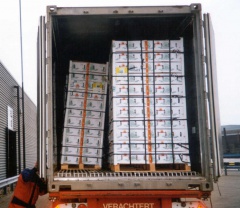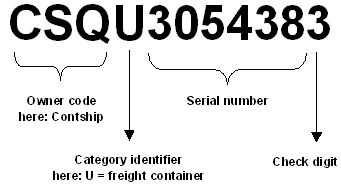Difference between revisions of "Containers (freight)"
(→Descpription) |
|||
| Line 16: | Line 16: | ||
The original choice of 8 foot height for ISO containers was made in part to suit a large proportion of railway tunnels, though some had to be deepened. With the arrival of even taller containers, further enlargement is proving necessary.<br><br> | The original choice of 8 foot height for ISO containers was made in part to suit a large proportion of railway tunnels, though some had to be deepened. With the arrival of even taller containers, further enlargement is proving necessary.<br><br> | ||
<b>Container coding, identification and marking</b><br> | <b>Container coding, identification and marking</b><br> | ||
| − | ISO 6346 is an international standard covering the coding, identification and marking of intermodal (shipping) containers used within containerized intermodal freight transport. The standard establishes a visual identification system for every container that includes a unique serial number (with check digit), the owner, a country code, a size, type and equipment category as well as any operational marks. The standard is managed by the International Container Bureau (BIC). | + | ISO 6346 is an international standard covering the coding, identification and marking of intermodal (shipping) containers used within containerized intermodal freight transport. The standard establishes a visual identification system for every container that includes a unique serial number (with check digit), the owner, a country code, a size, type and equipment category as well as any operational marks. The standard is managed by the International Container Bureau (BIC).<br><br> |
| + | [[File: Container_coding.jpg]] | ||
Revision as of 11:51, 8 April 2013
| Infobox on Containers (freight) | |
|---|---|
| Example of Containers (freight) |  |
| Facts | |
| Origin | - |
| Stowage factor (in m3/t) | - |
| Humidity / moisture | - |
| Ventilation | - |
| Risk factors | - |
Containers (freight)
Contents
Descpription
Containers, freight
An intermodal container (also container, freight container, ISO container, shipping container, hi-cube container, box, conex box and sea can) is a standardized reusable steel box used for the safe, efficient and secure storage and movement of materials and products within a global containerized intermodal freight transport system. "Intermodal" indicates that the container can be moved from one mode of transport to another (from ship, to rail, to truck) without unloading and reloading the contents of the container. There are approximately seventeen million intermodal containers in the world of varying types to suit different cargoes.
For air freight the alternative and lighter IATA-defined Unit Load Device is used. Non-container methods of transport include Bulk Cargo, break bulk cargo and tank cars, tank trucks or oil tankers used for liquids or gases.
Container (ISO) standards
There are five common standard lengths, 20-ft (6.1 m), 40-ft (12.2 m), 45-ft (13.7 m), 48-ft (14.6 m), and 53-ft (16.2 m). United States domestic standard containers are generally 48 ft (15 m) and 53-ft (rail and truck). Container capacity is often expressed in twenty-foot equivalent units (TEU, or sometimes teu). An equivalent unit is a measure of containerized cargo capacity equal to one standard 20 ft (length) × 8 ft (width) container. As this is an approximate measure, the height of the box is not considered, for instance the 9 ft 6 in (2.9 m) High cube and the 4-ft 3-in (1.3 m) half height 20 ft (6.1 m) containers are also called one TEU.
The maximum gross mass for a 20 ft (6.1 m) dry cargo container is 24,000 kg, and for a 40-ft (including the 2.87 m (9 ft 6 in) high cube container), it is 30,480 kg. Allowing for the tare mass of the container, the maximum payload mass is therefore reduced to approximately 22,000 kg for 20 ft (6.1 m), and 27,000 kg for 40 ft (12 m) containers.
The original choice of 8 foot height for ISO containers was made in part to suit a large proportion of railway tunnels, though some had to be deepened. With the arrival of even taller containers, further enlargement is proving necessary.
Container coding, identification and marking
ISO 6346 is an international standard covering the coding, identification and marking of intermodal (shipping) containers used within containerized intermodal freight transport. The standard establishes a visual identification system for every container that includes a unique serial number (with check digit), the owner, a country code, a size, type and equipment category as well as any operational marks. The standard is managed by the International Container Bureau (BIC).












